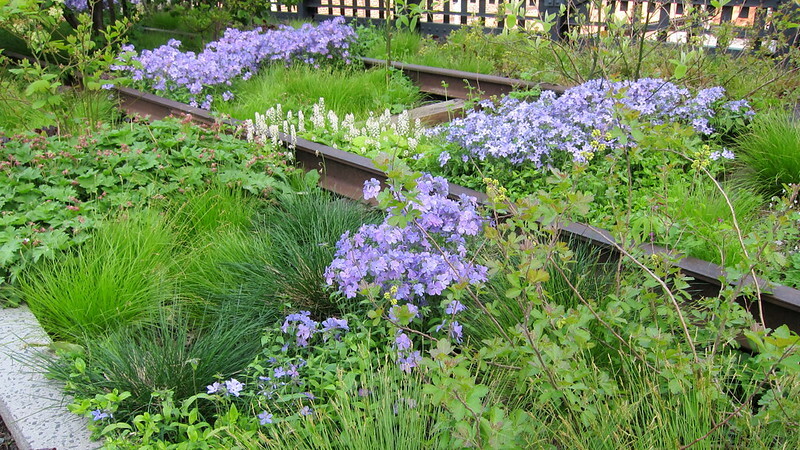Sumac is a native shrub or tree with many different varieties common throughout North America. The plants are important sources of food and shelter for a wide variety of local animals including birds and small mammals. The demand for these shrubs in the nursery trade has increased through breeding and selection of cultivars and natural sports.
Growing sumac as part of an ornamental garden plan not only encourages more wildlife to your outdoor space but also provides year-round interest. Sumac showcases brightly colored foliage in the fall and dramatic stem and trunk shapes during the bleak months of winter. It grows well in moist or dry soil and is not a hungry plant, preferring nutrient-poor and sandy areas of the garden.
The fast-growing and open shape of sumac makes it a good choice to add to a mixed hedge featuring native shrubs and trees. It can also be used to anchor a perennial bed that could use a lift during the winter when the plants have gone dormant.

Photo by K M, unmodified, Flickr, copyright CC BY 2.0 DEED
Shrubs To Plant With Sumac
Sumac makes a fantastic backdrop to other native or “nativar” shrubs. Plant lower-growing shrubs like ninebark, snowberry, serviceberry, red twig dogwood, and viburnum to highlight the shape of sumac. For a spectacular autumn display, plant sumac near oakleaf hydrangea, witch hazel, and blueberry bushes, which will complement the brilliant colors of sumac foliage in the fall.
Use drip irrigation or soaker hoses to help native and non-native shrubs fully establish in the first 2-3 years after planting. As the plants mature, supplemental watering is often only required during periods of extended heat or drought.

Photo by K M, unmodified, Flickr, copyright CC BY 2.0 DEED
Perennials To Plant With Sumac
Sumac grows well with most herbaceous perennials that prefer sun to part shade and average soil conditions. For contrast, plant Russian sage, crocosmia, foxglove, coreopsis, Shasta daisy, and bee balm, which all have a light and airy feel to them against the twisted, spreading limbs of sumac. For a subdued woodland vibe, combine sumac with native woodland plants such as Dutch man's pipe, sombrero coneflower, and euphorbia.
Underplant sumac with early spring blooming bulbs to create a colorful beginning to the gardening year. Select naturalizers like daffodils, Spanish bluebell, crocus, and checker lilies, which will fade by the time the later blooming herbaceous perennials begin to make an appearance.

Photo by K M, unmodified, Flickr, copyright CC BY 2.0 DEED
Annuals To Plant With Sumac
Annuals are great to use as a transition plant when first designing a garden. Meadow plants like cosmos, zinnia, cow parsley, and calendula can give a garden bed a feeling of openness even in the smallest yard. The bright blooms provide color all summer and attract native pollinators and other beneficial insects. Low-growing annuals like sweet potato vines, sweet alyssum, Forget-me-not, creeping zinnia and nasturtiums make for a temporary ground cover to suppress weeds while providing glorious color for months at a time.
Best Companion Plants For Sumac in Containers
Although sumacs can reach 10-11 feet in height, their root zone is rather shallow and compact, making them a good choice for large planters. The gnarly and twisted shape of the trunk and branches looks architectural and stunning during the winter, while the spreading limbs and foliage make a great focal point during the spring and summer.
Add filler and spiller plants to sumac containers to provide color during the growing season. Colorful spiller options include creeping Jenny, dark and light-colored sweet potato vines, and dichondra, which will soften the edges of the container. In a partially shaded spot, tuck heuchera, ferns, and hostas into spots around the sumac to give the container a woodsy feel.
Water the container regularly during the hottest parts of the summer and feed lightly with a diluted liquid fertilizer. Use a fish emulsion or seaweed mix early in late spring and then again in early July to boost the vigor and flowering of the plants.
Plants Not To Grow With Sumac
Although sumac is drought tolerant once established, it requires moist soil to reach its full potential. Planting sumac in a dry site with xeric plants may stunt the growth of these shrubs. Desert plants like cacti, sedums, and sage all require hotter and drier conditions than sumac can safely tolerate.
Best Plants To Grow With Sumac
The best plants to grow alongside sumac are those that are native to your climate. Naturalistic plantings can provide plenty of ornamental appeal as well as year-round interest. A ground-cover sumac, like Gro-Low, contrasts beautifully with tall phlox, hardy geranium, tiarella, and rush reeds. Use the larger sumacs, like tiger eyes, to anchor a planting with other native shrubs in a low-maintenance and naturalistic garden area.
Sources: “'Tiger Eyes' Staghorn Sumac, Rhus typhina.” Wisconsin Horticulture, Division of Extension. hort.extension.wisc.edu
